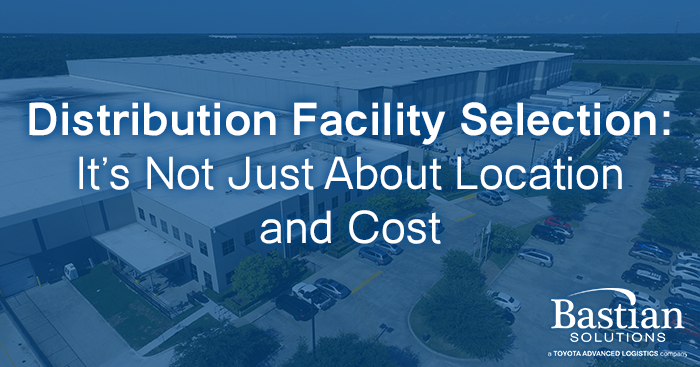
Distribution Facility Selection: It’s Not Just About Location and Cost
Wynn Watson | 06 March 2019
Business is growing, and you’ve recognized the need to move to a new facility to support the growth. It’s a great thing to be sure, but selecting the right new facility is still a challenge. Brick and mortar cost and location are high on the list, but let’s talk about some commonly missed but equally critical components that should be part of your building layout selection process.
Here are several key physical factors to evaluate when deciding on a new facility.
Clear Height
Clear height is the unobstructed vertical height from the floor to the roof support structure. Clear height determines how much vertical space you have to work with and can vary depending on building construction. It is important to understand and validate the advertised height versus any variations because it can significantly affect storage height for racking or automated storage media, pick module design including the numbers of levels that can be achieved, mezzanine possibilities for multi-level operations etc. A variation of a few feet can sometimes make a huge difference in capacity to support current and continued growth projections.
Column Spacing
Column Spacing is one of the most influential aspects of building design and significantly affects material handling equipment design and capacity. Pallet rack design options are very dependent upon the column grid spacing in any potential building. It is important to evaluate what you are getting on the front-end to avoid costly mistakes in implementation.
Innovations in the material handling equipment (MHE) industry in the last 10-15 years have caused most companies who warehouse to entertain narrow aisle or (NA) or very narrow aisle (VNA) racking for their storage equipment designs. That means anywhere from 5 foot to 11-foot aisles in the rack designs. Part of your analysis of building suitability should be how your storage equipment philosophy and equipment match building architecture to a degree that is reasonable. This is something a good material handling integrator can determine fairly quickly to help avoid costly mistakes.
Building Orientation
Orientation of the facility can be critical to productivity and efficiency of product flow. There are physical and operational considerations.
- Is the building square or rectangular?
- Are there restrictions to free flow of product like interior walls, between-column cross bracing or other obstructions?
- Are the dock doors on one side of the building, opposite sides of the building or on adjacent sides of the building?
- How many dock doors are present?
- How many could be made available?
These are all considerations for effectively determining whether a potential facility is right for your business. Consider a generally square building with dock doors on opposite sides of the warehouse. Receiving and shipping functions could be separated in this scenario which may work for certain operations, but every product must travel the entire depth of the building to get from receiving to shipping. If there is a significant need for cross-docking or pool-point distribution, this layout would not be ideal, not to mention the additional wear and tear on MHE over the long term. These processes would be better served in a rectangular warehouse where inbound and outbound processes share the same side, and MHE travel time is minimized.
The bottom line is that while building layout is not the only consideration in determining your next facility, it is often missed or is the last consideration. As business grows and the walls get tighter, engage your trusted material handling integration partner to help make decisions that are fiscally responsible and operationally feasible.
Learn more about our industrial project and development services.
Wynn is a Bastian Field Applications Engineer based in Jacksonville, FL. He has a Bachelor of Science degree in Mechanical Engineering from the United States Naval Academy and a Master of Science degree in Leadership, Education and Development from the Naval Postgraduate School. He as over 15 years experience in the material handling industry. His responsibilities include design engineering, customer relations, sales and project management for conveyor, automation and storage systems projects in the Northeast FL region.
Comments
No comments have been posted to this Blog Post
Leave a Reply
Your email address will not be published.
Comment
Thank you for your comment.